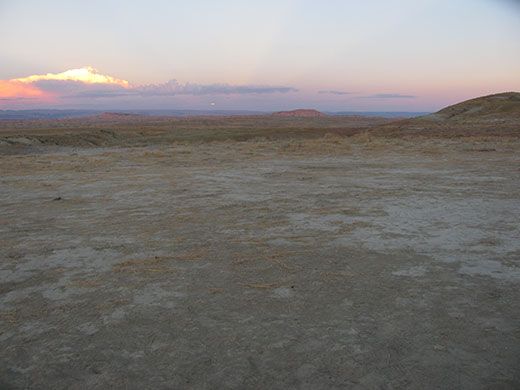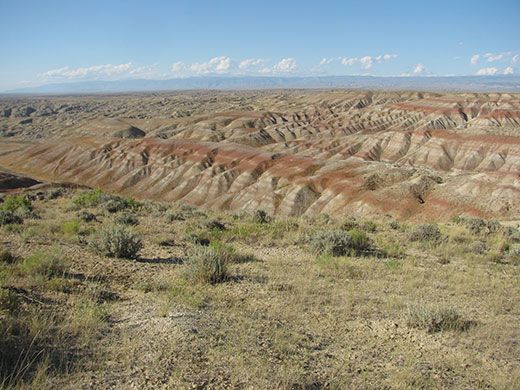Wyoming Paleontology Dispatch #9: Why It’s Called “Breaking Camp”
Some trick of the human psyche makes a patch of sagebrush feel like home
/https://tf-cmsv2-smithsonianmag-media.s3.amazonaws.com/filer/Wyoming-Dispatch-Bighorn-Basin-631.jpg)
My least favorite day of the year has arrived. Yesterday we completed one last hike prospecting the badland hills north of Worland where rocks deposited during the PETM are exposed. The search was fruitless—we found no new plant fossil sites, no last-day-of-the-field-season wonders. Today is the day we break camp, pack everything back into the little red shed at the Bureau of Land Management yard, and leave.
Breaking camp, striking camp, anyway you put it, taking down the tents we have lived in for the past month always makes me feel sad. It is strange, but I think most people feel it—one becomes emotionally attached to a spot of ground very quickly. We arrived here just a month ago. This was, and soon again will be, a bare patch of relatively flat ground dotted with sagebrush and cactus. We set up a tent for cooking, a few more tents for sleeping. Each day we woke here, breakfasted here, left for work from here, returned here in the evening, ate again, and sat here and talked as the sky overhead of this spot darkened and broke out in stars. Our only commitments to this place are our temporary use of it, the temporary structures we brought with us, and a ring of stones we made to contain the occasional campfire. Yet through some trick of the human psyche it feels like home. Taking down the tents and packing them into Dino destroys the home we have made our own simply through living in it and enjoying it for a few weeks. No wonder the term is “breaking camp.”
Of course there are other reasons to feel a little melancholy as we pull the tent stakes, fold the tarps, pack the bins of dishes, and empty the coolers of their last blocks of ice. We are all giving up the fellowship that grows among any small group that lives and works together in a challenging environment, even for a short time. I have seen this happen, field season after field season, for nearly 40 years now. Some groups mesh exceptionally well, with others there is more friction, but always people learn to help one another to some degree. They come to feel a common purpose. And almost always they feel a connection to this harsh landscape, even a little sense of owning the place by virtue of living in it.
We will also miss the relative independence that comes with fieldwork—we have had stretches of several days when we were unplugged from the world, with no phone or email. Until about 10 years ago our only non-emergency contact with the rest of the world was via snail mail and weekly phone calls that could be placed from a public pay phone in Worland. Now, improved cell-phone coverage has turned the hill behind camp into the “phone booth,” and it takes a conscious decision to separate from the rest of the world. The reward of separating is to be, temporarily, master of your own schedule and captain of your activities, able to focus entire days on the rocks and fossils in front of you without even the shadow of distraction by the outside world. It seems a radical act, and it is almost as addictive as collecting fossils.
Finally and most importantly, although fieldwork is physically hard and frequently monotonous, it also holds the possibility of great finds. In leaving I am giving up the chance that tomorrow I might walk around a nameless badland hill and find a spectacular new fossil site. The gambler in me wants to throw the dice a few more times. That is my main motivation for returning to the Bighorn Basin every summer. Some 20 years ago my colleague Bill DiMichele came to visit one of my field areas in the Bighorn Basin—I think curious that I continued to come back here year after year. One evening after dinner we walked to the top of a high butte near my camp and looked out onto an area of badlands called The Honeycombs, maybe 10 square miles of sharply weathered badland hills, each isolated from the next by ravines 50 to 100 feet deep, and each exposing on its sides rocks deposited in the last part of the Paleocene. Bill said what we were both thinking: “My God, you’ll never look at all that, it’s an endless labyrinth of outcrop just in this little area.” He was certainly right, but it remains fun to try.
We started packing not long after dawn so that we could complete the hardest work before it got hot, and by 10 a.m. our home is entirely packed and loaded into Dino. My poor old field vehicle is once again bulging at the doors. We take a last tour around our campsite, picking up the occasional small pieces of paper or plastic that have blown into the surrounding sage during summer windstorms. We all want to leave it as we found it, even if we don’t want to leave it at all. When we finish, the site is a barren, dusty, sage-spotted flat looking pretty much as it did when we got here. The fire ring, and a few smooth spots where tents were pitched are the only marks we have left.
Dino’s creaks and groans are louder than ever as I negotiate the camp road for a final time. Topping the first low hill outside of camp there is a large buck pronghorn standing by the two-track, grazing placidly. He looks up with mild interest as we pass, far more blasé than the usual pronghorn as we rattle by about 40 feet away. I like to imagine that he is patiently waiting for the “summer people” to leave and return the badlands to their regular state of sun-stunned, midday quietude. With any luck, though, we will be back in his territory next year. Who knows what we might find then?
Scott Wing is a research scientist and curator in the Smithsonian Institution’s Department of Paleobiology.
/https://tf-cmsv2-smithsonianmag-media.s3.amazonaws.com/accounts/headshot/SLW_photo_-James_Kegley_for_Smithsonian.jpg)


/https://tf-cmsv2-smithsonianmag-media.s3.amazonaws.com/accounts/headshot/SLW_photo_-James_Kegley_for_Smithsonian.jpg)